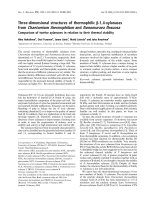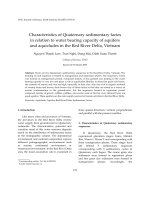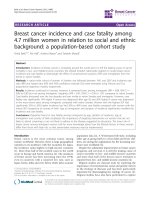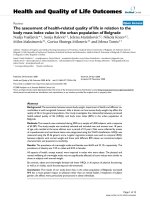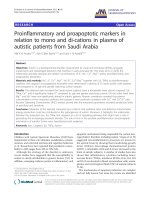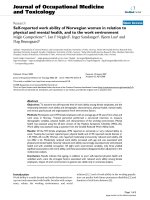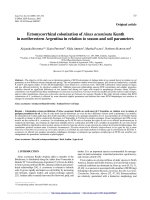Properties of water in foods in relation to quality and stability
Bạn đang xem bản rút gọn của tài liệu. Xem và tải ngay bản đầy đủ của tài liệu tại đây (21.29 MB, 691 trang )
Properties of Water in Foods
NATO ASI Series
Advanced Science Institutes Series
A Series presenting the results of activities sponsored by the NATO Science
Committee, which aims at the dissemination of advanced scientific and technological
knowledge, with a view to strengthening links between scientific communities.
The Series is published by an international board of publishers in conjunction with the
NATO Scientific Affairs Division
A
B
Life Sciences
Physics
Plenum Publishing Corporation
London and New York
C
Mathematical and
Physical Sciences
D. Reidel Publishing Company
Dordrecht and Boston
D
Behavioural and
Social Sciences
Applied Sciences
Martinus Nijhoff Publishers
Dordrecht/Boston/Lancaster
Computer and
Systems Sciences
Ecological Sciences
Springer-Verlag
Berlin/Heidelberg/New York
E
F
G
Series E: Applied Sciences - No. 90
Properties of
Water in Foods
in Relation to Quality and Stability
edited by
D. Simatos
Ecole Nationale Superieure de Biologle Appliquee
a la Nutrition et a l'Alimentation
Universite de Dijon
Dijon, France
J.L. Multon
Institut National de la Recherche Agronomlque
Nantes, France
1985
Martinus Nijhoff Publishers
Dordrecht I Boston I Lancaster
Published in cooperation with NATO Scientific Affairs Division
Proceedings of the NATO Advanced Research Workshop on Influence of Water on
Food Quality and Stability (ISOPOW III), Beaune, France, September 11-16, 1983
Library of Congress Catalog in Publication Data
NATO Advanced Research Workshop on Influence of
Water on Food Quality and Stability (1983
Beaune, France)
(NATO ASI series. Series E, Applied sciences
no. 90)
"Proceedings of the NATO Advanced Research Workshop
on Influence of Water on Food Qualtiy and Stability
(Isopow III), Beaune, France, September 11-16, 1983"-"Published in cooperation with NATO Scientific
Affairs Division."
Includes bibliographical references and index.
1. Food--Water activity--Congresses. I. Simatos, D.
II. Multon, J. L. (Jean Louis), 1938III. North Atlantic Treaty Organization.
Affairs Division.
TX553.W3N38
Scientific
IV. Title . .~. Series.
1983
664
85-4946
ISBN-13: 978-94-010-8756-8
ISBN-13: 978-94-010-8756-8
e-ISBN-13: 978-94-009-5103-7
001: 10.1007/978-94-009-5103-7
Distributors for the United States and Canada: Kluwer Boston, Inc., 190 Old Derby
Street, Hingham, MA 02043, USA
Distributors for the UK and Ireland: Kluwer Academic Publishers, MTP Press Ltd,
Falcon House, Queen Square, Lancaster LA 1 1RN, UK
Distributors for all other countries: Kluwer Academic Publishers Group, Distribution
Center, P.O. Box 322, 3300 AH Dordrecht, The Netherlands
All rights reserved. No part of this publication may be reproduced, stored in a
retrieval system, or transmitted, in any form or by any means, mechanical,
photocopying, recording, or otherwise, without the prior written permission of the
publishers,
Martinus Nijhoff Publishers, P.O. Box 163, 3300 AD Dordrecht, The Netherlands
Copyright © 1985 by Martinus Nijhoff Publishers, Dordrecht
Softcover reprint of the hardcover 1st edition 1985
v
Assistant
Editors
J.e. Cheftel
Laboratoire de Biochimie et Technologie Alimentaire
Universite des Sciences et Techniques du Languedoc
Montpellier - F.
H.B. Christian
Division of Food Research
CSIRO - North Ryde - N.S.W. - Australia.
R.B. Duckworth
Department of Bioscience and Biotechnology
University of Strathclyde - Glasgow - Scotland
- U.K.
F. Franks
Department of Botany
University of Cambridge - Cambridge - U.K.
G.W. Gould
Unilever Research - Colworth Laboratory
Bedford - U.K.
J. Kapsalis
U.S. Army Natick Research and Development Center
Natick - Mass - U.S.A.
M. Karel
Department of Nutrition and Food Science
Massachusetts Institute of Technology
Cambridge - Mass. - U.S.A.
J. Kirk
Campbell Soup Company
Camden - New Jersey - U.S.A.
M. Le Maguer
Food Science Department
University of Alberta - Edmonton - Alberta - Canada
LB. Rockland
Food Science Research Center
Chapman College - Orange - Cal. - U.S.A.
VII
Preface
Water is recognized as being an important factor in numerous phenomena connected with the quality of food. For instance, it plays a part
in the textural properties of several commodities. Moreover, water
is an essential parameter determining the behaviour of food products
in the course of many processing operations : on water, will depend
the amount of energy necessary for freezing or dehydrating the product;
water will strongly influence the evolution of physical, chemical and
biochemical phenomena taking place in the product during processing
operations such as heating, drying, etc. Water will also influence the
same reactions, as well as the activity of microorganisms, during the
storage of food products under various conditions. As a result, all aspects
of quality - sensory, nutritional and hygienic properties of the food
- will be affected.
In all these circumstances, the water content of a product is obviously
an important factor, but equally important may be the physical properties
of this water, such as its thermodynamic activity and its mobility. Actually, the concept of water activity (a ) is now widely used by the food
industry and in the legislation of sever')¥l countries.
The idea of a small, international meeting devoted to a synthetic
review and discussion of knowledge on these various matters, was first
developed by Dr. R.B. Duckworth who organized the symposium entitled:
Water Relations of Foods, held at the University of Strathclyde (Scotland)
in September 1974, under the auspices of Internatioral Union of Food
Science and Technology (IUFoS T). The proceedings , edited by R.B.
Duckworth, still serve as a useful source of reference material for any
food scientist or technologist concerned with the subject.
2
A second international conference (ISOPOW II), also sponsored by
IUFoS T, was organized to complement and supplement information reported in Glasgow and was held in Osaka (Japan) in September 1978. Contributions from Japanese scientists, who have had a traditional interest
in the preservation of foods through control of their water content
and water activity, introduced valuable new information. The proceedings3
were edited by L.B. Rockland and G.F. Stewart.
The third symposium of the series (ISOPOW III) was held in Beaune
(France) in September 1983. As for the previous meetings, the underlying
VIII
objective in designing the programme was to examine the relevance
of recent advances in fundamental knowledge on the subject to practical
problems, as they appear in the industrial processing of foods.
A very large amount of work has been devoted to the physical properties of water in foods, or more generally in biological systems. These
properties are commonly considered to play a major, even somewhat
magic, role in the structure and functioning of these materials. The
now classical concept of "bound water" can, however, now be replaced
by a more precise description of the state of water thanks to the various
physico-chemical techniques presently available. The first objective
then of ISOPOW III was to review the more recently acquired knowledge
concerning the properties of water in food materials and to reevaluate
the roles of water in phenomena of interest to the food scientist.
Sorption phenomena still receive special attention and it was appropriate to consider recently developed isotherm equations and some novel
experimental data on sorption hysteresis.
A better understanding of the effects of water on various phase transitions and reactions which can take place in food products at low and
intermediate moisture is highly desirable; The importance of the mobility
that water may impart to solutes and the effects of other possible mechanisms were discussed. Several non-equilibrium phenomena of great significance for the food industry were considered: superficial water activity,
diffusion of solutes and retention of aroma, rheology of hygroscopic
powders, effectiveness of packaging.
Although it may be argued that regarding "the cell as a simple osmometer" is a "gross over-simplification", food microbiologists find the
water activity concept extremely valuable as a determining factor for
microbial activity. It was thus appropriate to again review the present
state of knowledge on the ways water may control the activity of microorganisms. Then, the combined effects of a
and other environmental
factors on survival, growth and activity of s'i¥veral types of microorganisms were described, this knowledge being the basis for the promising
concept of "hurdles technology" which recently appeared and is being
increasingly more widely employed.
Intermediate moisture foods (IMF) and other water actIvIty - or
moisture - adjusted foods receive an increasing interest from the food
industry and a session of ISOPOW III was devoted to various practical
aspects of this question: evaluation of the water binding power of macromolecules, new humectants, manufacturing aspects.
Influences of water on quality in certain specific commodity groups
were treated: diffusion of water and solutes during processing and storage
of fish ; the water binding capacity of meat ; relationships between
composition, texture, microbial growth and a
in cheese ; prediction
of a in confectionery and sugar products.
w
w
IX
The freezing behaviour of water is a matter of prime importance
in a meeting like ISOPOW : the behaviour of water at low temperatures
is generally illuminating with regard to the state of water in the system
considered ; a better knowledge of this behaviour will also permit optimization of the freezing process for the preservation of foods and also
for the less well-known but interesting technique of freeze-texturing.
Finally, the important practical problems of moisture determination
was approached with a comparison of sensors for the measurement of
air humidity and a presentation of the results obtained in the course
of a collaborative European project (COST 90) aimed at developing a
standard method of isotherm determination.
Water Relations of Foods, 1975, R.B. Duckworth, ed., Acad. Press,
716 p.
2 International Symposium on the Properties of Water.
3 Water Activity : Influences on Food Quality, 1981. L.B. Rockland
and G.F. Steward, eds., Acad. Press, 921 p.
Acknow ledgments
The symposium was held under the auspices of the International Union
of Food Science and Technology (IUFoST) and of the Commission Internationale des Industries Alimentaires. It was allocated a grant from NATO,
as an Advanced Research Workshop.
Financial support was received from the following French agencies:
Ministere de l'Education Nationale, Ministere de l'Industrie et de la
Recherche, Direction des Industries Alimentaires et Agricoles, Institut
National de la Recherche Agronomique, Conseil Regional de Bourgogne.
The following companies also financially contributed to the organization
of, ISOPOW III : Allied Grocery Products, Arnott's Biscuits Pty Ltd,
¥s'~ Boake Allen Australia Ltd, Cadbury Schweppes Pty Ltd, Cottee's
Gener~l Foods Ltd, CSR Ltd, Sugar Division, H.J. Heinz Co. Australia
Ltd,
Biscuiterie Nantaise, Bridel, B.S.N. Gervais Danone, Lesieur-Cotelle,
Mars Alimentaire, Rowntree-Mackintosh S.A., Royal Canin, SOPAD-Nestle,
Societe des Produits du MaYs (France). Maizena Gesellschaft mbH
(Germany). Ajinomoto Co., Ajinomoto-General Foods Co., Coca Cola
Japan, Eizai Co., Fuji Seiyu Co., Hasegawa Koryo Co., Kagome Co.,
Kaneegafuchi Kagaku Kogyo Co., Kikkoman Co., Kirin Beer Co., Knorr
x
Shokuhin Co., Kureha Kagaku Kogyo Co., Lion Co., Meiji Nyugyo Co.,
Meiji Seika Co., Morinaga Seika Co., NIhon Reizo Co., Nisshin Seifun
Co., Shiseido Co., Takara Shuzo Co., Takeda Yakuhin Kogyo Co., Toyo
Seikan Co., Yamasu Shoyu Co., Yukikrushi Nyugyo Co. (Japan). C.P.e.
Nederland B.V. (Nederland). Cadbury Schweppes, Devro, Finlay, Londreco,
Mars, Rank Hovis, Unilever, United Biscuits (United Kingdom). Beckman
Instruments, Bristol-Myers, General Mills Inc., Gerber Foods Inc., Hershey
Foods Corp., ITT Continental Baking Co., e.H. Knorr, Lipton, The Pillsbury
Company, Mc Cormick and Company Inc, Proctor and Gamble (U.S.A.)
The editors wish to acknowledge the kind and efficient efforts in
organizing and promoting ISOPOW III of L.B. Rockland, President of
the Permanent Executive Committee of ISOPOW-IUFoST and of all
the members of the ISOPOW III Coordinating Committee : S. Arai, J.e.
Cheftel, B. Colas, J. Dardenne, J.F. Diehl, R.B. Duckworth, M. Fujimaki,
S. Gal, A.e. Hersom, M. Karel, J. Kefford, T.P. Labuza, G. Lavoue,
M. Le Meste, D. Lorient, F. Leistner, e. van den Berg, E. von Sydow.
The editors also express their thanks to all who have contributed
to the quality of this book : authors for careful preparation of their
manuscripts, members of the editorial committee for pertinent review
of the submitted papers. The efforts of B. Colas, M. Le Meste and M.L.
Bettenfeld, who have kindly collaborated in the final editing work are
gratefully acknowledged, as are those of N. Desbois for secretarial
services and for the typing of the whole proceedings.
D. SIMATOS
J.L. MULTON
XI
CONTENTS
Assistant Editors
Preface
V
VII
Acknowledgements
IX
Contributors
XV
Other Participants in the Symposium
XIX
Session 1. Fundamentals: high moisture systems
Water and aqueous solutions : recent advances
F. Franks
Phase separation in protein - water systems and the formation
of structure
M.P. Tombs
25
The
system
37
An enzymatically· modified protein as a new surfactant
and its function to interact with water and oil in an emulsion
system
S. Arai and M. Watanabe
49
dipalmitoylphosphatidylcholine (DPPC) -
R. Perron
water
Session 2. Fundamentals : low and intermediate
moisture systems
The influence of soluble components on water sorption hysteresis
K.A. Johnston and R.B. Duckworth
65
Some facts concerning water vapour sorption hysteresis
on potato starch
H. Bizot, A. Buleon, N. Mouhous-Riou and J.L. Multon
83
Influence of temperature on sorption equilibria
H. Weisser
Development of B.E.T.-like models for sorption of water
on foods, theory and relevance
C. van den Berg
Solution thermodynamics and the starch-water system
M. Le Maguer
95
119
133
XII
Session 3. Physico-chemical and enzymatic changes
Effects of water activity and water content on mobility
of food components, and their effects on phase transitions
in food systems
M. Karel
Enzyme activity as a function of water activity
R. Drapron
153
171
The influence of water content and temperature on the
formation of Maillard reaction intermediates during the
drying of plant products
K. Eichner, R. Laible and W. Wolf
Polysaccharide-water interactions
thermal behavior
rice starch
T.J. Maurice, L. Slade, R.R. Sirett and C.M. Page
of
191
211
Session 4. Microbiology and water activity
Present state of knowledge of a effects on microorganisms
G.W. Gould
w
Effects of a and pH on growth and survival of
w
Staphylococcus aureus
J.A. Troller
229
247
Effect of a on growth and survival of Bacillaceae
M. Jakob~en
259
Effect of water activity on mold growth and mycotoxin
production
D. Richard-Molard, L. Lesage and b "';ahagnier
273
The antimicrobial activity of sugar against
wounds and other infections of man
S. Selwyn and J. Durodie
293
pathogens of
Hurdle technology applied to meat products of the shelf
stable product and intermediate moisture food types
L. Leistner
309
Session 5. Technology : diffusion properties and
non equilibrium states
Fundamentals of diffusion of water and rate of approach
of equilibrium a
T. Roth and fK. Loncin
331
Diffusivity of sorbic acid in food gels at high and intermediate
water activities
S. Guilbert, A. Giannakopoulos and J.C. Cheftel
343
XIII
Aroma diffusion : the influence of water activity and of
molecular weight of the other solutes
A. Voilley and M. Le Meste
357
Choice of packages for foods
of water activity
C. Mannheim and N. Passy
375
with specific consideration
The role of water in the rheology of hygroscopic food powders
M. Peleg
393
Session 6. Technology: humectants and new intermediate
moisture foods (IMF)
A pragmatic approach to the development of new intermediate moisture foods
C.J.B Brimelow
Ij.05
Water binding of humectants
T.P. Labuza
1j.21
Novel intermediate moisture meat products
D.A. Ledward
41j.7
Extrusion cooking for cereal-based intermediate moisture
products
P. Linko, R. Kervinen, R. Karppinen, E.K. Rautalinna
and J. Vainionpaa
Polyglycerols and poly glycerol esters as potential water
activity reducing agents. Chemistry and sensory analysis
J.G. Kapsalis, D.H. Ball, D.M. Alabran and A.V. Cardello
465
481
Session 7. Freezing and low temperature phenomena
Complex aqueous systems at subzero temperatures
F. Franks
1j.97
The freezing of biological cells in aqueous solutions containing a polymeric cryo-protectant
C. Korber, K. Wollhover and M.W. Scheiwe
511
Freezing in
water
G. Blond
531
polymer
-
water
systems and
properties
of
Freeze-texturing and other aspects of the effects of freezing
on food quality
P.J. Lillford
51j.3
Computed instrumental analysis of the behavior of water
in foods during freezing and thawing
N. Nagashima and E. Suzuki
555
XIV
Session 8. Commodities : properties of water and technology
Water in fish: its effects on quality and processing
M. Kent
573
The effect of water on the quality of meat and meat products:
problems and research needs
R. Hamm
591
Water in dairy products ·related
reference to cheese
M. Ruegg
603
Confectionery and water activity
by calculation
G. Bussiere and M. Serpelloni
to
quality,
with special
determination
of a w
627
Session 9. Moisture measurement and prediction
Comparison of
K. Schurer
sensors
for
measurement
of
S tandardiza tion of isotherm measurements
90 and 90 bis)
W. Wolf, W.E.L. Spiess and G. Jung
Index
air
humidity
(COS T-project
647
661
681
xv
Contributors
Alabran D.M., U.S. Army Natick Research and Development Center,
Natick, Massachusetts 01760, U.S.A.
Arai S., Department of Agricultural
Tokyo, Bunkyo-ku, Tokyo 113, Japan
Chemistry,
The
University
of
Ball D.H., U.S. Army Natick Research and Development Center, Natick,
Massachusetts 01760, U.S.A.
Van den Berg c., Department of Food Science, Section Food and Bioengineering, Agricultural University Wageningen, Netherlands
Bizot H., Laboratoire de Stockage et Conservation des Denrees Alimentaires, I.N.R.A., Centre de Recherches de Nantes, Rue de la
Geraudiere, 44072 Nantes Cedex, France
Blond G., Laboratoire de Biologie Physico-Chimique, Ecole Nationale
Super ieure de Biologie Appliquee
la Nutrition et
II Alimentation,
Universite de Dijon, France
a
a
Brimelow C.J.B., Londreco Limited, Hayes, Middlesex, United Kingdom
Buleon A., Laboratoire de Stockage et Conservation des Denrees Alimentaires, I.N.R.A., Centre de Recherches de Nantes, Rue de la
Geraudiere, 44072 Nantes Cedex, France
Bussiere G., Roquette, 62136 Lestrem, France
Cahagnier B., Laboratoire de Stockage et Conservation des Denrees
Alimentaires, I.N.R.A., Centre de Recherches de Nantes, Rue de
la Geraudiere, 44072 Nantes Cedex, France
Cardello A.V., U.S. Army Natick Research and Development Center,
Natick, Massachusetts 01760, U.S.A.
Cheftel J.C., Laboratoire de Biochimie et Technologie Alimentaires,
Universite des Sciences et Techniques, 34060 Montpellier, France
Drapron R., Station de Technologie Alimentaire, I.N.R.A.,
Olympiades, 91305 Massy, France
1 avo des
Duckworth R.B., Division of Food Science, Department of Bioscience
and Biotechnology, University of Strathclyde, Glasgow, Scotland
Durodie J., Department of Medical Microbiology, Westminster Medical
School, University of London, Horseferry Road, London S W1P 2AR,
United Kingdom
XVI
Eichner K., Institut fUr Lebensmittelchemie der Universitat Munster,
Piusallee 7, D - 4400 Munster, Fed. Rep. of Germany
Franks F., Department of Botany, University of Cambridge, Cambridge
CB2 3EA, United Kingdom
Giannakopoulos A., Laboratoire de Biochimie et Technologie Alimentaires,
Universite des Sciences et Techniques, 34060 Montpellier, France
Guilbert S., Laboratoire de Biochimie et Technologie Alimentaires,
Universite des Sciences et Techniques, 34060 Montpellier, France
Gould G.W., Unilever Research Laboratory, Colworth House, Sharnbrook,
Bedford MK44 lLQ, United Kingdom
Hamm R., Federal Center for Meat Research, E.C. Baumann Strasse
20, D 8650 Kulmbach, Fed. Rep. of Germany
Jakobsen M., Alfred Jorgensen Laboratory for Fermentation
Frydendalsvej 30, DK 1809 Copenhagen V, Denmark
Ltd.,
Johnston K.A., Division of Food Science, Department of Bioscience
and Biotechnology, University of Strathclyde, Glasgow, Scotland,
United Kingdom.
Jung G., Federal Research Centre for Nutrition, Karlsruhe, Fed. Rep.
of Germany
Kapsalis J.G., U.S. Army Natick Research and Development Center,
Natick, Massachusetts 01760, U.S.A.
Karel M., Department of Nutrition and Food Science, Massachusetts
Institute of Technology, Cambridge, Massachusetts 02139, U.S.A.
Karppinen R., Department of Chemistry, Laboratory of Biochemistry
and Food Technology, Helsinki University of Technology, 02150
Espoo 15, Finland
Kent M., Torry Research Station, 135 Abbey Road, Aberdeen, Scotland
Kervinen R., Department of Chemistry, Laboratory of Biochemistry
and Food Technology, Helsinki University of Technology, 02150
Espoo 15, Finland
Korber C., Helmholtz-Institut fur Biomedizinische Technik an der
RWTH Aachen, Goethestr. 27-29, D 1500 Aachen, Fed. Rep. of
Germany
Labuza T.P., Department of Food Science and Nutrition, University
of Minnesota, Saint Paul, Minnesota 55108, U.S.A.
Laible R., Fraunhofer-Institut fUr
packung, Schragenhofstrasse 35,
of Germany
Lebensmitteltechnologie und VerD 8000 Munchen 50, Fed. Rep.
Ledward D.A., Department of Applied Biochemistry and Food Science,
School of Agriculture, University of Nottingham, Sutton Bonington,
Loughborough, LE12 5RD, United Kingdom
XVII
Leistner L., Federal Centre for Meat Research, 8650 Kulmbach, Fed. Rep.
of Germany
Le Maguer M., Food Science Department, University of Alberta, Edmonton,
Alberta, Canada, T6G 2P5
Le Meste M., Laboratoire de Biologie Physico-Chimique, Ecole Nationale
Superieure de Biologie Appliquee a la Nutrition et a l'Alimentation,
Universite de Dijon, France
Lesage L., Laboratoire de Stockage et Conservation des Denrees Alimentaires, I.N.R.A., Centre de Recherches de Nantes, Rue de la
Geraudiere, 44072 Nantes Cedex, France
LiHford P.J., Unilever Central Resources, Colworth House Laboratory,
Sharnbrook, Bedford, MK44 lLQ, United Kingdom
Linko P., Department of Chemistry, Laboratory of Biochemistry, and
Food Technology, University of Technology, 02150 Espoo 15, Finland
Loncin M., Department of Food Engineering of the University, D 7500
Karlsruhe, Fed. Rep. of Germany
Mannheim C., Department of Food Engineering and Biotechnology,
Technion, Israel Institute of Technology, Haifa 32000, Israel
Maurice T.J., General Foods Inc., Cobourg, Ontario, Canada
Mouhous-Riou N., Laboratoire de Stockage et Conservation des Denrees
Alimentaires, I.N.R.A., Centre de Recherches de Nantes, Rue de
la Geraudiere, 44072 Nantes Cedex, France
Multon J.L., Laboratoire de Stockage et Conservation des Denrees
Alimentaires, I.N.R.A., Centre de Recherches de Nantes, Rue de
la Geraudiere, 44072 Nantes Cedex, France
Nagashima N., Central Research Laboratories,
Suzuki-cho, Kawasaki-ku, Kawasaki 210, Japan
Ajinomoto
c.,
Inc.
Page C.M., General Foods Inc., Cobourg, Ontario, Canada
Passy N., Department of Food Engineering and Biotechnology, Technion,
Isarel Institute of Technology, Haifa 32000, Israel
Peleg M., Department of Food Engineering, Agricultural Engineering
Building, University of Massachusetts, Amherst MA 01003, U.S.A.
Perron R., C.N.R.S., 2
a 8 rue
H. Dunant, 94320 Thiais, France
Rautalinna E.K., Department of Chemistry, Laboratory of Biochemistry
and Food Technology, University of Technology, 02150 Espoo 15,
Finland
Richard-Molard D., Laboratoire de Stockage et Conservation des Denrees
Alimentaires, I.N.R.A., Centre de Recherches de Nantes, Rue de
la Geraudiere, 44072 Nantes Cedex, France
Roth T., Department of Food Engineering of the University, D 7500
Karlsruhe, Fed. Rep. of Germany
XVIII
Ruegg M., Federal Dairy Research Institute, CH 3097 Liebefeld,
Switzerland
Scheiwe M.W., Helmhotz-Institut fUr Biomedizinische Technik an der
RWTH Aachen, Goethestr. 27-29, D 1500 Aachen, Fed. Rep.of
Germany
Schurer K., Technical and Physical Engineering Research Serv., 6700
AJ Wageningen, Netherlands
Selwyn S., Department of Medical Microbiology, Westminster Medical
School, University of London, Horseferry Road, London S WIP 2AR,
United Kingdom
Serpelloni M., Roquette, 62136 Lestrem, France
Sirett R.R., General Foods Inc., Cobourg, Ontario, Canada
Slade L., General Foods Corp., Tarrytown, N.Y., U.S.A.
Suzuki E., Central Research Laboratories, Ajinomoto Co., Inc. Suzukicho, Kawasaki-ku, Kawasaki 210, Japan
Spiess W.E.L., Federal Research Centre for Nutrition, Karlsruhe, Fed. Rep.
of Germany
Tombs M.P., Unilever Research Laboratory, Sharnbrook, United Kingdom
Troller J.A., Procter and Gamble Co., Cincinnati, Ohio 1+5222, U.S.A.
Vainonpaa J., Food Research Laboratory, Technical Research Centre
of Finland, 02150 ESPOO 15, Finland
Voilley A., Laboratoire de Biologie Physico-Chimique, Ecole Nationale
Superieure de Biologie Appliquee
la Nutrition et
l'Alimentation,
Universite de Dijon, France
a
a
Watanabe M., Department of Agricultural Chemistry,
Tokyo, Bunkyo-ku, Tokyo 113, Japan
University of
Weisser H., Institute of Food Process Engineering, Kaiserstrasse 12,
D 7500 Karlsruhe 1, Fed. Rep. of Germany
Wolf W., Bundesforschungsanstalt fUr Ernahrung,
20, D 7500 Karlsruhe 1, Fed. Rep. of Geq:nany
Engesser
Strasse
Wollhover K., Helmholtz-Institut fUr Biomedizinische Technik an der
RWTH Aachen, Goethestr. 27-29, D 1500 Aachen, Fed. Rep. of Germany
XIX
Other participants in the symposium
Beltzung P., Merck - Chimie, 5, rue Anquetil, 94-130 Nogent S/Marne,
France
Bigalli G., Hershey Foods Co., 1025 Reese Avenue, B.P. 805, Hershey
PA 17033, U.S.A.
Biller M., Maizena G.mbH, 1 Knorrstrase, B.P. 2760, D 7100 Heilbronn,
Fed. Rep. of Germany
Biton J., Universite de Technologie de Compiegne, B.P. 233,
60206 Compiegne, France
Bone D.P., The Quaker Oats Company, 617 W. Main Street, Barrington,
IL 60010, U.S.A.
Bousquet-Ricard M.,
France
B.S.N./Crealis, Z.I. Le Teinchurier,
19100 Brive,
Bousset J., Laboratoire de Recherches sur la Viande, INRA,
78350 Jouy en Josas, France
Buckle K., School of Food Technology, University of New South Wales,
P.O. Box 1, Kensington, NS W 2033, Australia
Bureau Go, A.D.R.I.A.C., Universite de Reims, B.P. 34-7,
51062 Reims Cedex, France
Buyukkoksal Go, Marmara Research Institute, P.O. Box 21, Gebze, Kocaeli,
Turkey
Catherin Co, Mars Alimentaire, Route de Bitche, 67500 Haguenau,
France
Caurie Mo, Federal Polytechnic, P.O. Box 50, Haro, Nigeria
Chicherio A.E.,
Novasina
AG,
Thurgauerstr.
50,
8050
Zurich, Suisse
Christian J., Division of Food Research C.S.I.R.O., B.P. 52,
2113 North Ryde N.S.W., Australia
Colas Bo, Laboratoire de Biologie Physico-Chimique, ENS.BANA,
Universite de Dijon, 21100 Dijon, France
Combes Do, Departement de Genie Biochimique, I.N.S.A., Avenue
de Rangueil, 31077 Toulouse Cedex, France
xx
Condliffe W.F., H.J. Heinz Co Ltd, Hayes Park, Hayes,
Midd UB4 8AL, United Kingdom
Corry J., Ministry of Agriculture Fisheries and Food,
65 Romney Stret, London 5 WIP 3 RD, United Kingdom
Cowley K.M., United Biscuit, St. Peter's Road, Furze platt,
Maidenhead, Berkshire SL6 7QU, United Kingdom
Dame M., Laboratoire Soredab, La Boissiere Ecole, 78120 Rambouillet,
France
Daniau G., Vandamme - Pie qui Chante, 300 rue Clemenceau,
59139 Wattignies, France
Davidson P., Hygrodynamics Inc., 949 Selim road, Sdverspring,
'MD 20910, U.S.A.
Demeaux M., Laboratoire de Biochimie Alimentaire, ENS.BANA,
Universite de Dijon, 21100 Dijon, France
Qeveau J., Compagnie des Salins du Midi et des Salines de l'Est,
24 route d'Aulnay, 93140 Bondy, France
Ericsson B., Department of Food Technology,
B.P. 740, 5 - 220 07 Lund, Sweden
University of Lund,
Gal S., Haco Ltd, 3073 Gumlingen, Suisse
GaugazM., Societe d' Assistance Technique pour
S.A., B.P. 88, 1814 La Tour de Peilz, Suisse
les Produits Nestle
Gellf G., Universite de Technologie de Compiegne, B.P. 233,
60206 Compiegne Cedex, France
Getchell R., MC Cormick & Co., 202 Wight Avenue, Hunt Valley,
Maryland 21154, U.S.A.
Ghiasi K., Pillsbury Co., 311 2nd st. S-E., Minneapolis, MN 55414,
U.S.A.
Girod I., Societe des Produits du MaTs, 379 avo du General de Gaulle,
92142 Clamart, France
Glittenberg D., MaTzena G.mbH, 1 Knorrstrasse, B.P. 2760,
o 7100 Heilbronn, Fed. Rep. of Germany
Harding W., Mars LTD, Dundee Rd., Slough SLl 4JX, United Kingdom
Henry M., C.N.R.S., 2 rue Henry Dunant, 94320 Thiais, France
Hermansson A.M., SIK, The Swedish Food Institute, B.P. 5401,
40229 Goteborg, Sweden
Hyvonen L., University of Helsinki, B-talo Viikki, 0071 0 Helsinki,
Finland
Ilari J.L., E.N.I.T.I.A.A., Rue de la Geraudiere, 44072 Nantes Cedex,
France
XXI
Kimizuka A., Central Research Laboratories - Ajinomoto
1-1 Suzuki-cho - 210 Kawasaki-ku, Kawasaki, Japan
Co.,
Inc.
Kirk J., Campbell Soup Company, Camden, New Jersey, U.S.A.
Klaarenbeek T., Smiths Food Group bv, Westelijke Randweg 5,
1721 CH Broek op Langedijk, Netherland
Lacout J.M., Rowntree Mackintosh, Rue de Cluj, B.P. 30,
21019 Dijon Cedex, France
Lang K., General Foods Research Department,
Cobourg, Ontario K9A 4L4, Canada
520
William
Street,
Lavoue G, Laboratoire de Biochimie Alimentaire, ENS.BANA, Universite
de Dijon, 21100 Dijon, France
Leblanc M., Societe Jules Richard & Pekly, 116 Quai de Bezons,
95102 Argenteuil, France
Legenhausen R.F., Beckman Instruments, 89 Commerce Road,
Cedar Grove, NJ 07009, U.S.A.
Le Meste M., Laboratoire de Biologie Physico-Chimique, ENS.BANA,
Universite de Dijon, 21100 DIJON, France
Le Mestre G., Rutter' Instrumentation,
94360 Bry S/Marne, France
126 rue du General Leclerc,
Lerici C.R., University of Bologna, 7 via S. Giacomo, 40126 Bologna,
Italia
Loisel c., E.N.I.T.I.A.A., rue de la Geraudiere, 44072 Nantes Cedex,
France
Lorient D., Laboratoire de Biochimie Alimentaire, ENS.BANA, Universite
de Dijon, 21100 Dijon, France
Makishima S., Meiji Seika Co., 580 Horikawacho, Saiwaiku 210,
Kawasaki, Japan
Masteil M., Institut Scientifique et Technique des Peches Maritimes,
B.P. 1049, 44034 Nantes Cedex, France
Mathlouthi M., I.U.T., Universite de Dijon, B.P. 510,
21014 Dijon Cedex, France
Motarjemy Y., Lunds University, B.P. 50, 230 53 Alnarp, Sweden
Musso F., Francereco, 3 rue Charles Tellier, 60000 Beauvais, France
Nagashima N., Central Research Laboratory, Ajinomoto Co.,
Suzuki-cho, Kawasaki-ku, Kawasaki, Japan
Ollivon M., C.N.R.S., 2 rue Henry Dunant, 94320 Thiais, France
Pascat B., A.D.R.I.A.C., Universite de Reims, B.P. 347,
51062 Reims Cedex, France
Pelaez J., Mc Cormick & Co., 202 Wight Avenue, Hunt Valley,
Maryland 21031, U.S.A.
XXII
Perrier L., Generale Biscuit France, 4 rue Edouard Vaillant,
91201 AThis-Mons, France
Porzio M., General Mills Inc., 9000 Plymouth Avenue N., Minneapolis,
Minn 55427, U.S.A.
Rieunier F., Biscuiterie Nantaise, rue Lotz-Cosse, B.P. 5X,
44040 Nantes Cedex, France
Rockland L., Food Science Research Center, Chapman College,
333 GLassel Street, Orange CA 92666, U.S.A.
Slinde E., Norvegian Food Research Institute, As - NLH N 1432,
Norway
Switka J., Department of Catering, Merchant Navy Academy,
Czerwonich Kosynierow, Gdynia 81-225, Poland
Thibeaudeau P., Royal Canin, B.P. 234, 56006 Vannes Cedex, France
White C., Campden Food Preservation Research Assoc.,
Campden, Gloucestershire GL55 6LD, United Kingdom
Yigit V., Marmara Research Institute,
Turkey
PO Box 21,
Chipping
Gebze,
Kocaeli,
WAT ER AND AQUEOUS SOLU TI ONS
RECENT ADVA NCES
F. Franks
i.
IN TRO DUCTI ON
The past five years have wi tnessed some s i gnificant advances in t he
physics , phys i cal chemistry and biochemis t ry of water and processes
involving water . They extend from the es timat ions of re l iable potential func t ions to descr ibe water- water interactions t o the basic
mechanisms tha t underlie the phenomena associated wi t h the sur vival
of l i ving organisms under conditions of extreme physiological water
s tress . This review can only provide keywords and signposts which
the i nt eres t ed r eade r should follow by consulting recent review
publ i cations cited at t he end of t his chapter .
I shall deal with the various topics in increasing order of conce ptual comp l exi t y . This is not to say t hat concep t ual simplicity goes
hand in hand with s i mplicity in execu t ion . Conceptually nothing could
be much simpler or mo r e impor t ant than t he calculat i on of the interaction energy between two isolated water molecules ; this is however
a task which s ti ll confounds theoreticians . The problems that a r ise
if a thi r d molecule is included in such calculations have yet to be
solved . On the other hand , the appl i cations of advanced diffract i on
t ec hniques have led to the deta i led desc r iption of conceptually more
complex systems , such as the hydration shell of an ion in solution
or t he distribution of wa t e r molecu l es surrounding native pr~ins .
2,
THE INTERACTIONS BETWEEN TW O ISO L., b.TE D WATER ~iO L E C U LE S
AS A BASIS FOR LIQ UI D S TATE CALCULAT I ONS
The molecular pa i r potential f unc tion Uij(r , Q) i s probably the most
fundamental quantity required fo r the development of a molecular
D. Simalos and J.L. Multon (editors), Properties of Waler in Foods_ ISBN 97(H4·01()'8756-8
© 1985, Martinus Nijhoff Publishers, Dordracht.
2
F. Franks
description of a liquid. Here Uij describes the potential energy
between interacting molecules i and j as function of the distance of
separation r and the angles describing the mutual orientation of the
two molecules, D. In the case of water the calculation of Uij is made
difficult because of : 1) the almost tetrahedrally disposed charges
on the H20 molecule and 2) uncertainty about the exact description
of the water-water hydrogen bond. Even if the interaction energy
between two molecules could be calculated exactly, the question must
arise whether the macroscopic properties of a liquid can be obtained
by the pairwise addition of these energies, or whether effects due
to cooperativity (interactions between 3 or more molecules) need to
be taken into account.
Several recent computer simulation approaches are on record for
the calculation of Uij. The much used ST2 is a pairwise additive
potential based on the water molecules as regular tetrahedra with
four point charges placed at the vertices. It was optimized against
the known properties of liquid water and it is therefore an "effective" pair potential. Clementi et al. devised a pair potential (CL)
based on high level quantum mechanical calculations and using a three
point charge model for H20. More recently Finney and his colleagues
have attempted to include cooperativity effects by introducing a
dipole polarizability term into their calculations which are not
based on the assumption of molecular tetrahedrality.
A comparison of the three models against the experimental properties of water shows up their respective advantages and shortcomings.
For instance, Figure I is such a comparison for the temperature
dependency of the 2nd virial coefficient, B(T) of water vapour.
Essentially B(T) measures the deviation from ideal gas behaviour. As
expected, ST2, being a model optimized for the liquid state, fails,
whilst F performs well. Testing the water models against the measured
radial distribution functions, g(r) as obtained from X-ray and neutron
scattering by liquid water, allows detailed analyses to be made.
Thus, X-ray data refer mainly to oxygen atom distributions, goo(r),
while for neutrons the scattering cross sections for 0 and D are of
the same order of magnitude. Information on local molecular orientations is therefore obtainable. It seems that none of the models can
closely match the details of the various g(r) functions.
The consistency of the three models can also be explored by
calculations of the potential energy at constant distance of separation of the oxygen atoms, but at varying orientations. Effectively
this corresponds to the distortion of the hydrogen bond by rotating
one of the two molecules. Figure 2 shows such a potential energy
diagram ; position A is the equilibrium configuration that exists in
ice-I. By performing a trans-cis transformation, we arrive at position
B where the resultant molecular dipole are aligned. It is seen that
the ST2 and F models indicate double minima, but the CL model only
exhibits a broad minimum. Major discrepancies between the two models
Water and aqueous solutions
3
ST2
UgU/Lc. I. Sc.~oYld V-ZJula£ ~0c.66-z~-zc.nt B(Tj 06 Wa-tc.fL vapoU/l, a6 ~a£w
w-tc.d by d--l66c.fLC.Yl-t mo£c.w£a!L pa--lfL po-tcYl-tta£ 6UYl~U:0n6 ; 601'0 duc~U:J.J
-6 c.c. -tc.x-t. RC.pfLOducc.d, wah pejlm~W-6~OYl, 6fLom F-zYlHcy (I j •
also arise in the repulsive part of the interaction, corresponding
to H-H crowding along the 0-0 line of centres. Here the ST2 and F
water models appear to predict insufficient repulsion (compared to
the best quantum mechanical calculations) whereas the CL model is
too repulsive by approximately 50 kJ mol- i (N.B. kT = 2 kJ mol-i).
At the second level of approximation the structure of liquid water
now understood in terms of a more or less randomly hydrogen bonded
network, but this level is inadequate to account for some of the
subtle water mediated biological effects, e.g. the detailed role of
hydration in maintaining macromolecular native states. To make further
progress we require better molecular potential functions and it is
likely that these will require an improved treatment of cooperative
effects as well as a more realistic model of the H20 molecule itself.
lS
F. Franks
4
ST2 _._.
AT 3;\
F
CL ..... .
30
.,
~
E
20
o
E
\
:i
i
\
\
\.
10
I:
dd
:
\. ':
\ '.
.I :'
I
\
o
c
C
.,
"0
-10
I .:
\
i :'
"\
I
".\
-20
:'
/
". \
A
'. \
a..
:
i :
\
100 •
/
/------200'
300'
ANGLE
rcgWLe. 2. The. OIUe.iU:a.UOVl de.pe.Vlde.Vlc.e. onothe. H20-H20 pote.nlia.€.
bLmc.DOVl at a Mxe.d 0- 0 ciL0taVlc.e. 0 b 3 A. POhil).On6 A and B c.ofULe.hpond to the. mLLtua.€. olUe.l1taUoVlh hhown. The. ST2 c.U!Lve. hhou..td be.
cUhp.tac.e.d down by 4.5 /cJ mo.€.- 1. Re.cvWWI1, w.{th aUe.fLau oVlh, nfLom
F.{i1I1. e.y , (1).
3.
IONIC HYDRATION: THE STRUCTURE OF THE IONIC HYDRATION
SHELL IN SOLUTION
A proper description of the hydration shell surrounding an ion
has until now been lacking. A knowledge of the structural details of
water molecules in the neighbourhood of an ion forms the basis of an
understanding of the equilibrium and dynamic properties of solutions
of electrolytes and in the interactions of (hydrated) ions with
macromolecules.
Until recently the behaviour of the ion lin solution could only be
treated by assigning to the solvent various averaged bulk properties,
such as a dielectric permittivity or a viscosity. This type of
approach formed the basis of the Born equation which describes the
